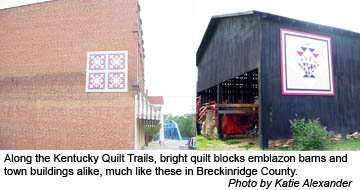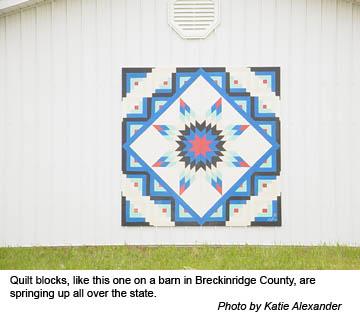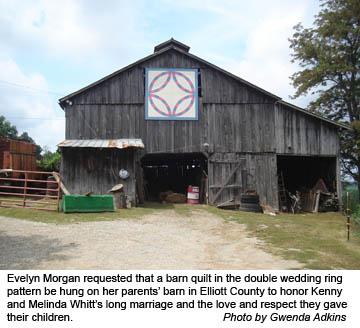Barn Quilts Blanket the State
Barn Quilts Blanket the State

Whether it's due to nostalgia, pride of place or the desire to bring tourism dollars into the state, barn owners across Kentucky are blanketing their buildings with quilt blocks as part of the burgeoning Kentucky Quilt Trails.
The beautification movement began about three years ago in Carter County with the installation of “Grandma’s Flower Garden” on the barn of Grace and Dean Ramey. Originally part of the Clothesline of Quilts, a tri-state effort to decorate Ohio, Kentucky and Tennessee byways with traditional quilt designs, the Kentucky portion of the Clothesline is now officially called the Kentucky Quilt Trails. The idea has since spread across the state from its original nine-county Gateway Resource Conservation and Development area in eastern Kentucky. University of Kentucky Cooperative Extension works hand-in-hand in many areas with RC&D to promote and construct the blocks.
Tony Burnett, Gateway RC&D Coordinator, said the quilts represent and honor farm wives’ contribution to the farm and rural life.
“Traditionally, that was their role,” he said. “It was the cooking and the cleaning and the actual quilting. This ties their work into the work required to run a farm.”
The quilts come in two sizes, 4-by-4 or 8-by-8 wooden squares painted with bright colors that can be affixed to a barn or fence. Some are constructed so they can be freestanding in a field. Counties that have jumped into the movement find it isn’t hard to attract participants.
In Stamping Ground, the Buffalo Gals Extension Homemaker Club committed to building the barn quilts as a community service project. Beginning a little more than a year ago, their goal was to establish a quilt trail in Scott County before the 2010 World Equestrian Games at the Kentucky Horse Park. The idea proved to be popular. The club has constructed and installed more than 70 quilt blocks, with another 20 in progress. Carole Landry, club member, thinks the popularity of the barn quilts has to do with a number of things. “I think quilts are really, really popular right now, and barn quilts have been getting quite a bit of coverage in newspaper articles and magazines,” she said. “Plus the preservation of tobacco barns – that interests the farmers, where the quilts interest farmers’ wives. Plus, we’re trying to get it promoted as an art project, so the kids in school will see art everyday as they drive by on the school buses, and they’ll realize ordinary people can create art.”
“I think quilts are really, really popular right now, and barn quilts have been getting quite a bit of coverage in newspaper articles and magazines,” she said. “Plus the preservation of tobacco barns – that interests the farmers, where the quilts interest farmers’ wives. Plus, we’re trying to get it promoted as an art project, so the kids in school will see art everyday as they drive by on the school buses, and they’ll realize ordinary people can create art.”
Farther west, Katie Alexander, Breckinridge County family and consumer sciences agent, is one of the people behind a budding quilt trail in the Lincoln Trail area. Breckinridge, Grayson, Hardin, Larue, Meade and Washington Counties are all in various stages of the process. The area is preparing for an onslaught of tourists for the Abraham Lincoln Bicentennial Celebration in 2008, and it’s hoped that the quilt trail will encourage travelers to branch out and explore the entire region. Marion County, too, plans to start their trail in the coming spring. Alexander’s county kicked off their part of the trail last April with a public event to unveil the first quilt block in the county, one that was purchased by the county’s extension homemakers. Since then 11 quilt squares have been installed, with four more to be hung by the end of the year.
“We’re hoping to get it all the way across the state. Get it all the way over to Paducah, of course, the Quilt Capital of Kentucky,” Alexander said.
People who are interested in having a quilt block on their property must fill out an application, which is reviewed by a site committee. The committee makes sure the block can be seen from the road and that the owners won’t mind people pulling off the road and taking pictures of it. The barn or building must also be in good condition and be accessible to the heavy equipment needed to install the block.
The price for a quilt block varies from area to area, often depending upon whether grants or donations have been received by the sponsoring agency. Gwenda Adkins, family and consumer sciences agent in Elliott County, said extension program money paid for the first block in her county because she wasn’t sure if the idea would catch on. It did. That prompted her to apply for a grant from the W. Paul and Lucille Caudill Little Foundation, which paid for installing many of the first blocks in Elliott. In Scott County and the Lincoln Trail Area, the fee charged for an 8-by-8 block is $200, which covers the cost of the board and a high quality exterior paint. The boards are painted by volunteers. In some areas, the local Rural Electric Cooperative Corporation has volunteered to install the quilt blocks for no charge. This is an example of the collaboration between local organizations that is a hallmark of the trails in many counties.
The choice of a pattern is left to the purchaser, many of whom select patterns that honor a loved one or evoke fond memories. Alexander said that often the patterns are from quilts that have been handed down from a grandmother or great-grandmother, “something they’ve had in their family for a long time with special meaning to them.”
At the beginning of the project in Elliott County, the people ordering the quilt blocks were not the ones Adkins expected.
“The men wanted a quilt square on their barns in memory of their moms quilting,” she said. “It surprised me, because I thought women would want it because it was women who quilted. But that wasn’t who called at the beginning. It was the men who called and said, ‘I want one of those. It reminds me of my mom and the way she always sat around and made our quilts for us.’ They all have a story about their memories of their moms quilting.” Gwenda Adkins also recalled Elliott County resident Evelyn Morgan who wanted the double wedding ring pattern hung on her parents’ barn to symbolize all the years they’d been married and the lessons they taught their children about respect and love. Unfortunately, Morgan’s mother, Melinda Whitt, passed away before the block could be hung, but her father, Kenny, is able to enjoy it today as a tribute to his late wife and their long marriage.
Gwenda Adkins also recalled Elliott County resident Evelyn Morgan who wanted the double wedding ring pattern hung on her parents’ barn to symbolize all the years they’d been married and the lessons they taught their children about respect and love. Unfortunately, Morgan’s mother, Melinda Whitt, passed away before the block could be hung, but her father, Kenny, is able to enjoy it today as a tribute to his late wife and their long marriage.
Adkins says that the personal stories attached to the quilt squares are their true and lasting importance.
“Yes, the quilts are beautiful, and they’re decorating the landscape, and they’re creating community spirit, but there’s a story behind that quilt square somewhere.”
For people like Katie Alexander, Carole Landry and Gwenda Adkins, the Kentucky Quilt Trails is a way to bridge distances between people and their life experiences.
More information about Kentucky Quilt Trails can be found through the local Cooperative Extension office or online at http://www.kentuckyquilttrail.org.